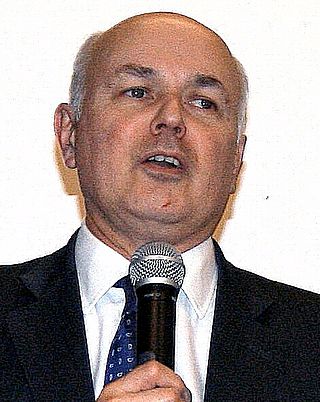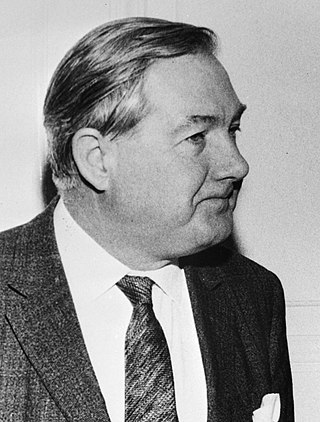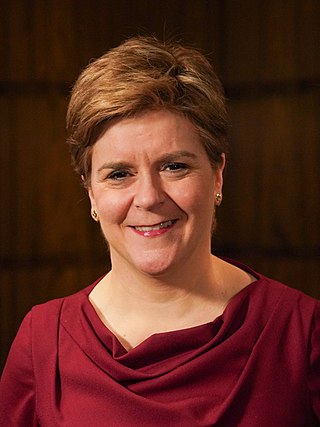
The single transferable vote (STV), a type of proportional ranked choice voting (P-RCV), is a multi-winner electoral system in which each voter casts a single vote in the form of a ranked-choice ballot. Voters have the option to rank candidates, and their vote may be transferred according to alternative preferences if their preferred candidate is eliminated or elected with surplus votes, so that their vote is used to elect someone they prefer over others in the running. STV aims to approach proportional representation based on votes cast in the district where it is used, so that each vote is worth about the same as another.
The politics of Edinburgh are expressed in the deliberations and decisions of the City of Edinburgh Council, in elections to the council, the Scottish Parliament and the UK Parliament.

The 2003 United Kingdom local elections were held on Thursday 1 May 2003, the same day as the Scottish Parliamentary and the Welsh Assembly elections. There were local elections for all councils in Scotland and in most of England. There were no local elections in Wales, Northern Ireland or London.

Berwickshire, Roxburgh and Selkirk is a constituency of the British House of Commons, located in the south of Scotland within the Scottish Borders council area. It elects one Member of Parliament (MP) at least once every five years using the first-past-the-post system of voting. Since 2017 the MP has been John Lamont of the Conservative Party.

Scottish Westminster constituencies were Scottish constituencies of the House of Commons of the Parliament of Great Britain, normally at the Palace of Westminster, from 1708 to 1801, and have been constituencies of the House of Commons of the Parliament of the United Kingdom, also at Westminster, since 1801. Constituency boundaries have changed on various occasions, and are now subject to both periodical and ad hoc reviews of the Boundary Commission for Scotland.

The 2007 United Kingdom local elections were held on Thursday 3 May 2007. These elections took place in most of England and all of Scotland. There were no local government elections in Wales though the Welsh Assembly had a general election on the same day. There were no local government elections in Northern Ireland. Just over half of English councils and almost all the Scottish councils began the counts on Friday, rather than Thursday night, because of more complex arrangements regarding postal votes.

Elections for the Scottish district councils were held in 1977.

The 2011 United Kingdom local elections was held on Thursday May 5. In England, direct elections were held in all 36 Metropolitan boroughs, 194 Second-tier district authorities, 49 unitary authorities and various mayoral posts, meaning local elections took place in all parts of England with the exception of seven unitary authorities, and seven districts and boroughs. For the majority of English districts and the 25 unitary authorities that are elected "all out" these were the first elections since 2007. In Northern Ireland, there were elections to all 26 local councils. Elections also took place to most English parish councils.

Local elections were held in Scotland on Thursday 3 May 1984, to elect members to all 53 district councils under the Local Government (Scotland) Act 1973, which had established the two-tier system of regions and districts. This was the first election to take place after the 1983 general election landslide victory for the Conservatives. The local elections resulted in the Labour Party taking control of the City of Edinburgh District Council for the first time.

Elections for the Scottish district councils were held in 1980.

Elections to Angus Council were held on 3 May 2012 the same day as the other Scottish local government elections. The election used the eight wards, created as a result of the Local Governance (Scotland) Act 2004, with each ward electing three or four councillors using the single transferable vote system form of proportional representation, with 29 Councillors being elected.

Elections for the City of Edinburgh District Council took place on Thursday 3 May 1984, alongside elections to the councils of Scotland's various other districts.

Elections to Strathclyde Regional Council were held on Thursday 5 May 1994, on the same day as the eight other Scottish regional elections. This was the final election to the regional council which was abolished in 1995 along with the 19 district councils and replaced by 12 unitary authorities following the implementation of the Local Government etc. (Scotland) Act 1994.

The 2022 United Kingdom local elections took place on Thursday 5 May 2022. These included elections for all London borough councils, and for all local authorities in Wales and Scotland. Most seats in England were last up for election in 2018 and in Scotland and Wales in 2017. The elections coincided with the 2022 Northern Ireland Assembly election. In 91 cases, most of them in Wales, council seats were uncontested, each having only one candidate. Three seats in Scotland remained unfilled as no one nominated to fill them.

The 2022 Scottish local elections were held on 5 May 2022, as part of the 2022 United Kingdom local elections. All 1,226 seats across all 32 Scottish local authorities were up for election and voter turnout was 44.8%.
Elections to Cumnock and Doon Valley District Council were held on 5 May 1988, on the same day as the other Scottish local government elections. This was the fifth election to the district council following the local government reforms in the 1970s.
Elections to Kilmarnock and Loudoun District Council were held on 5 May 1988, on the same day as the other Scottish local government elections. This was the fifth election to the district council following the local government reforms in the 1970s.
Elections to Kilmarnock and Loudoun District Council were held on 3 May 1984, on the same day as the other Scottish local government elections. This was the fourth election to the district council following the local government reforms in the 1970s.
Dalmellington was one of 32 electoral wards of East Ayrshire Council. Originally created in 1974, the ward was initially within Cumnock and Doon Valley District Council before the local government reforms in the 1990s. The ward elected one councillor using the first-past-the-post voting electoral system.
Catrine and Sorn was one of 10 electoral wards of Cumnock and Doon Valley District Council. Created in 1974, the ward elected one councillor using the first-past-the-post voting electoral system.













